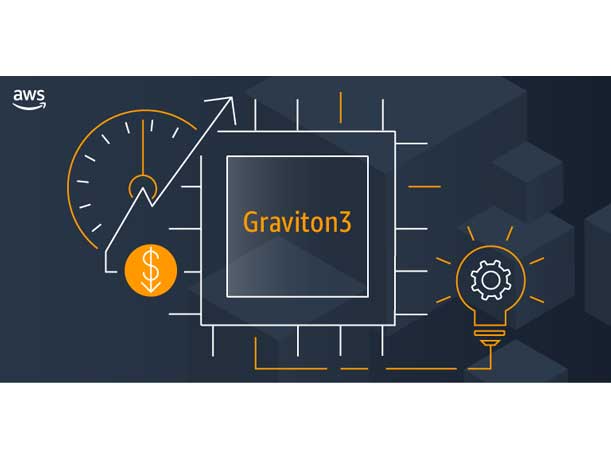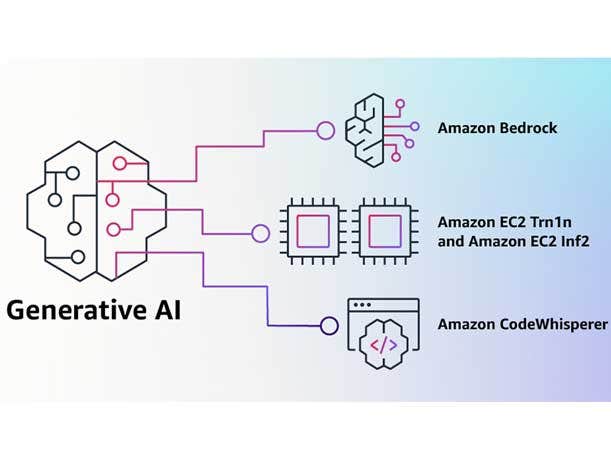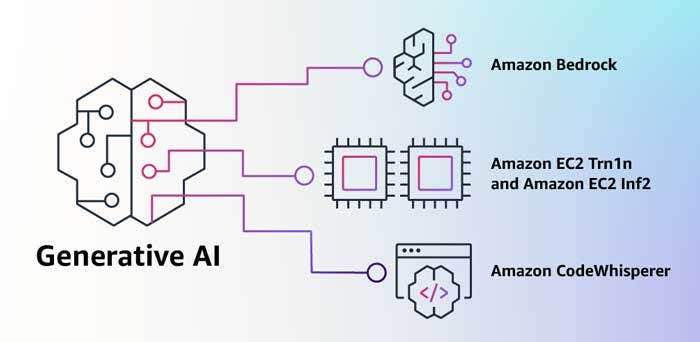The 10 Biggest AWS News Stories Of 2023 (So Far)
From layoffs and slow sales growth to AI innovation and entering new markets, here are the top 10 most important AWS news stories of 2023 thus far.

From diving deeper than ever into artificial intelligence to one of the largest layoff rounds in the cloud company’s history, there has been no shortage of news from Amazon Web Services so far in 2023.
The $85 billion Seattle-based cloud computing global market share leader has seen a slowdown in sales growth this year so far, but continues to unleash new products, programs and strategic agreements with channel partners at a rapid race.
AWS is also arguably growing its cloud computing footprint and customer reach faster than its competitors by pouring billions into building new data centers both in the U.S. and abroad.
[Related: AWS’ New Cyber Insurance ‘Industry-Shaping’ Program: 5 Big Things To Know]
AWS’ 2023 Highlighted By Layoffs, Generative AI Push
AWS is trying to capitalize on the largest IT market trend seen in years: generative AI.
The cloud company launched new services and partnerships this year with the ultimate goal of becoming a force in the generative AI race between itself and the likes of Google and Microsoft. “We’re really excited about how AWS is now democratizing access to foundational models and generative AI for customers,” said Ruba Borno, vice president, head of worldwide channels and alliances for AWS, in an interview with CRN this year.
The other significant news story in the tech world this year was the waves of layoffs across the entire IT industry. AWS was unaffected by parent company Amazon’s first wave of 18,000 employee layoffs this year. However, the cloud company wasn’t immune to Amazon’s next layoff round of 9,000 employees.
CRN breaks down the top 10 most important AWS news stories of 2023—from layoffs and slow sales growth to a renewed focus on CPUs and new AI innovation—that AWS partners, investors and employees should know about.

No. 10: Amazon Cuts 18,000 Employees; But Andy Jassy Affirms AWS Commitment
This year saw a slew of IT companies of all shapes and sizes conduct large layoffs rounds—from several hundred employees to tens-of-thousands. As 2023 kicked off, AWS parent company Amazon announced it would be laying off more than 18,000 employees.
This caused some initial concern that AWS employees could be impacted by the massive layoff round inside Amazon. Sources told CRN at the time that AWS would not be significantly impacted by the 18,000 layoff round. The layoffs ultimately affected Amazon stores as well as its human resources People, Experience and Technology (PXT) organization.
The big news story for AWS here was how Amazon CEO Andy Jassy—who was formerly AWS’ CEO—publicly affirmed his company’s relentless commitment to its cloud organization. During Amazon’s quarterly earnings report right after announcing the 18,000 layoffs, Jassy said, “We have a lot of growth in front of us in our AWS business.”
“Think about how different a company Amazon would be today if we hadn’t invested in AWS,” Jassy said. “And so that informs some of the other meaningful investments we’re making beyond our stores, in retail and advertising, and AWS businesses.
The Takeaway: Amazon understood how important AWS is to leave its cloud company out of the 18,000-layoff round. However, as sales growth lowered and economic uncertainty continued throughout the year, Amazon did eventually cut some AWS employees.

No. 9: AWS Dives Headfirst Into Cyber Insurance Industry; ‘An Industry-Shaping Movement’
When AWS spends two-and-a-half years researching and building something—from new products to incentive programs—it means serious business.
Not widely known for its cybersecurity insurance initiatives or even as a facilitator, AWS saw something big in launching its new Cyber Insurance Program that looks to match AWS partners and customers with cyber insurance companies, while at the same time, streamlining the entire insurance process.
Instead of businesses working for weeks or months trying to obtain cyber insurance, AWS guarantees a quote within two days. AWS is looking to team up with large cyber insurers like Cowbell Cyber Insurance and Marsh, as well as smaller brokers and dealers that can help SMB customers. When a cyber insurance company offers recommendations to customers about how to improve their security posture, AWS will call on channel partners to snap up those sales opportunities.
“I call this an industry-shaping moment,” AWS’ Ryan Orsi, worldwide head of cloud foundations for the AWS Partner Network, told CRN in June. “At this company, we do have a history of looking into market segments and technologies that are in need of reinvention. I would say the cyber insurance industry is in need of reinvention for the era of cloud.”
The Takeaway: AWS is unbashful about entering new, complex IT markets where it sees a big opportunity. Enabling faster and better cyber insurance for its customers could lead to huge opportunities for partners and potentially sometime bigger down the line for Amazon.

No. 8: AWS Focuses On CPUs To Combat New Demand For AI
AWS has invested years designing custom silicon chips optimized for the cloud. In 2023, the company doubled down on innovation as demand grows thanks to new generative artificial intelligence and machine learning use cases.
AWS recently launched its Arm-based mchips for high-performance computing (HPC) workloads as well as its new Inferentia2 chip, which offers up to four times higher throughput and 10 times lower latency than its first Inferentia processor. On the generative AI front, AWS created a new Trn1n instance this year on AWS Trainium chips to train generative AI models on.
“With the enormous upcoming growth in machine learning, customers will be able to get a lot more done with AWS’ training and inference chips at a significantly lower cost,” said Amazon CEO Andy Jassy. “We’re not close to being done innovating here, and this long-term investment should prove fruitful for both customers and AWS.”
AWS, as well as Google and Microsoft, seem to be implementing a chip strategy that involves both organic and inorganic innovation as the cloud providers seek access to more chip power from the likes of Nvidia. In fact just this week, AWS is reportedly considering using AI chips from AMD into some of its hardware.
The Takeaway: Andy Jassy says it best, “AWS is still in the early stages of its [chip] evolution, and has a chance for unusual growth in the next decade.”

No. 7: AWS Marketplace Hits 330,000 Active Customers
The goal is for AWS Marketplace to eventually become the one-stop shop for customers to buy cloud solutions online from Amazon and its partners. The number of regular buyers from the online store has been steadily increasing in 2023, now exceeding more than 330,000 customers.
“We have over 330,000 customers that transact on a regular basis on the AWS Marketplace,” AWS’ global channel chief, Ruba Borno, told CRN in May. “We’re excited to make that a place where our SI [systems integrator] partners can reach new customers.”
To further buying and selling via the cloud marketplace, AWS recently launched new capabilities into the AWS Marketplace, including Amazon Elastic Kubernetes Service (EKS) integrations and two new Amazon QuickSight dashboards. Additionally, AWS added new features such as search auto-complete, which allows customers to easily discover a partner’s product listing.
Companies like networking giant Cisco as well as many independent software vendors (ISVs) and channel partners are placing more and more of their offerings on the AWS Marketplace.
The Takeaway: If the first half of 2023 is any indicator, AWS will continue to put emphasis and investment in the online store. It appears AWS Marketplace will grow this year in the amount of both buyers and sellers who want to transact on the marketplace.

No. 6: AWS Doubles Down On Strategic Collaboration Agreements (SCA) With Channel Partners
This year, AWS is taking some of its channel partner relationships to the next level by forming a slew of new strategic collaboration agreements (SCA).
AWS formed SCA’s with partners of all shapes and sizes—from consultancy specialists Rebura and OpsGuru to cloud services standouts Crayon and Innovative Solutions.
Channel partners who form these agreements with AWS are typically provided extra financial incentives and enablement resources—such as additional technical training and marketing development funds (MDF)—aimed at driving joint sales and new customer opportunities. Many AWS partners leverage these SCA’s as a springboard to grow their employee headcount, customer base and AWS certifications.
For example, AWS Premier Tier Services Partner Innovative Solutions planned to hire 200 new employees and win 1,000 net new SMB customers over the next few years by signing the SCA agreement. “[AWS] sees that the role of the partner is to shepherd every one of these small to midsize business customers at scale. They can’t do it on their own,” said Innovative’s CEO Justin Copie told CRN this year. “AWS wants us to build sales teams that go in, understand a customer’s business need, and then help align the right AWS technology that fits that business versus just slam-dunking technology in.”
The Takeaway: With the investments by AWS in these SCAs, it shows that Amazon is putting its money where its mouth is when it comes to long-term channel commitment.

No. 5: AWS Innovation: Top 5 New Solutions Launched In 2023
If 2023 proved anything, it’s that regardless of layoffs and macroeconomic uncertainty, AWS will always create new services and offerings for its partners and customers.
From new generative AI tools to supply chain services, the cloud giant launched a slew of new tools that had the market buzzing.
Some of the most important new solutions launched in 2023 by AWS include Amazon Bedrock to help build and scale generative AI applications; Amazon Security Lake, which centralizes security data from AWS environments, SaaS providers, on-premises and cloud sources into a purpose-built data lake; and a new serverless option for its popular AWS Database Migration Service (DMS).
There’s still some lingering supply chain issues stemming from the global COVID-19 pandemic. To help solve this issue, AWS’ new Supply Chain service aims to help leaders mitigate risks and increase supply chain resilience by unifying data, providing machine learning-powered connectors and offers built-in contextual collaboration. One final new offering this year is Amazon CodeCatalyst, a software development and delivery service that enables teams to quickly plan, develop, build and deliver applications on AWS, with the goal of reducing friction throughout the development life cycle.
The Takeaway: AWS looks to strike while the iron is hot. The company created new solutions in emerging or red-hot markets to meet customer demand as seen with its supply chain, chip and generative AI launches.

No. 4: AWS Pours Billions Into Global Data Center Expansion
AWS is arguably expanding its cloud computing footprint faster and wider than any company in the world by building new data centers that power its cloud services.
Amazon has already spent billions in 2023 on building and expanding AWS data center campuses both in the U.S. and overseas.
This year, Amazon said it will invest $12.7 billion in new data centers in India to expand its cloud capabilities and customer base in the region. Additionally, AWS this year announced plans to invest $6 billion in data centers in Malaysia. In 2023, AWS launched two new AWS Local Zones in Australia and Chile, which are all powered by its data centers.
Inside America, AWS announced plans to invest a massive $35 billion in building new data centers across Virginia over the next several years. The cloud company is also set to build five new data centers in Oregon after local officials in May approved tax breaks worth an estimated $1 billion.
The Takeaway: AWS has the power, cash, authority and customer base to spend billions this year on building new data centers to grow its cloud market share. Don’t expect a slowdown in data center expansion in 2023.

No. 3: Sales Growth Slowdown
AWS witnessed one of its slowest sales growth quarters ever during the first quarter of 2023. AWS generated $21.4 billion in revenue in Q1 2023, representing a 16 percent sales increase year over year.
Although over $21 billion in sales is nothing to be dismissive about, the 16 percent year over year growth rate raised some eyebrows as AWS has historically reported sales growth in the twenties to thirties percentage range. For example, in first quarter 2022, AWS sales grew a whopping 37 percent year over year.
AWS executives blamed the relatively low year over year sales growth on companies being cautious about their IT budgets this year. “While our AWS business navigates companies spending more cautiously in this macro environment, we continue to prioritize building long-term customer relationships both by helping customers save money and enabling them to more easily leverage technologies,” said Jassy (pictured) during Amazon’s Q1 2023 earnings report.
In February, AWS reported fourth quarter 2022 sales of $21.4 billion, representing flat sales quarter over quarter and a 20 percent growth rate year over year.
“As we look ahead, we expect these [customer] optimization efforts will continue to be a headwind to AWS growth in at least the next couple of quarters,” said Amazon’s CFO Brian Olsavsky, in February.
The Takeaway: It appears AWS expects year-over-year sales growth to continue to be in the teens and twenties in 2023, compared to growth rates in the thirties which company witnessed in prior years. However, it’s key to note that AWS ranks No. 1 in global cloud market share, owning 32 percent market share as of first quarter 2023, followed by Microsoft at 23 percent share and Google Cloud at 10 percent share.

No. 2: Second Layoff Round Hits AWS
AWS is Amazon’s most profitable business. The company was unscathed during Amazon’s first layoff round of over 18,000 employees in January.
However, in March, Amazon unveiled a new round of 9,000 layoffs inside the company, which would see the departure of some AWS employees. The company told CRN the 9,000-employee layoff round would impact a “small, single-digit percentage” of AWS staff.
AWS consistently declines to say how many people it employs globally. However, the terminations means at least hundreds, more likely a few thousand, of AWS employees were cut.
It could have been the single largest layoff round in AWS’ history, although layoff and employment figures cannot be officially verified.
“The role reductions in AWS were driven by reprioritization decisions, which required us to reallocate resources,” an AWS spokesperson to CRN at the time. “In most cases this involved people shifting projects, priorities or teams, but in some cases we didn’t have the right skill match for these priorities.”
CRN reviewed dozens of LinkedIn posts from AWS employees who were laid off, many of which appear to be relatively new employees—having joined the company within the past few years. Employees who were laid off included: software development engineers, senior and enterprise account executives, cybersecurity consultants, senior cloud architects, DevOps consultants, senior specialist solutions architects, software development engineers, and data scientist managers.
The Takeaway: In 2023, AWS likely conducted its largest layoff round since the cloud subsidiary was formed in 2006. It’s definitely something to keep an eye on for remainder of the year. However, Microsoft laid off 10,000 employees and Google cut 12,000 jobs this year as well.

No. 1: Generative AI Takes Center Stage At AWS In 2023
AWS’ most bullish push thus far in 2023 is undoubtably in artificial intelligence, specifically around the growing generative AI market.
The $85 billion company launched new AI-specific programs, products, services and formed brand new partnerships with vendors in a move to plant its AI stake in the ground.
On the innovation front, AWS launched Amazon Bedrock for building and scaling generative AI applications; new ML-powered features in Amazon SageMaker to help businesses generate insights from documents, images and texts; as well as new Amazon EC2 Inf2 instanced aimed specifically at lowering the cost of running large-scale AI workloads.
To drive AI sales and customer mindshare, AWS has started providing resources to channel partners to help them begin or advance their generative AI customer journey, including accelerators such as AWS Solutions Library, AWS Solutions Construct and Partner Solutions Factory. For example, the Partner Solutions Factory allows the channel to collaborate with AWS experts on system architecture, designs and demos around AI.
AWS has also formed new partnerships with AI startups and generative AI-focused vendors this year. One big partnership was with AI startup Hugging Face aimed to accelerate the training and deployment of models for generative AI applications.
“We’re really excited about how AWS is now democratizing access to foundational models and generative AI for customers,” Ruba Borno, vice president, head of worldwide channels and alliances for AWS, told CRN this year.
Amazon CEO Andy Jassy said he’s bullish that AWS can become a leader in generative AI.
“Generative AI has burst onto the scene and promises to significantly accelerate machine learning adoption,” said Amazon’s CEO this year. “We have been working on our own LLMs [Large Language Models] for a while now, believe it will transform and improve virtually every customer experience, and will continue to invest substantially in these models across all of our consumer, seller, brand, and creator experiences.”
The Takeaway: AWS has a big, bright and bold future in generative AI. “Let’s just say that LLMs and generative AI are going to be a big deal for customers, our shareholders, and Amazon,” said Jassy.